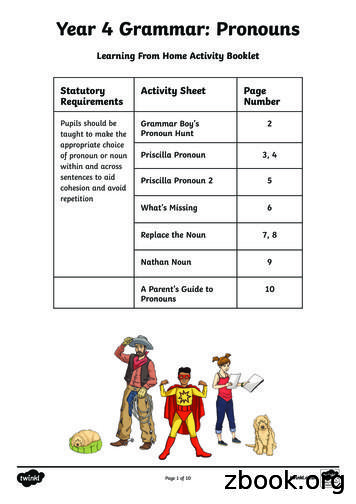Pronouns In Translational Lithuanian
Pronouns inTranslational LithuanianDr. Jurgita VaičenonienėDr. Jolanta KovalevskaitėCentre of Computational LinguisticsVytautas Magnus University
Research background, questions and data “Tolerance of interference . tend to increase whentranslation is carried out from a ‘major’ or highly prestigiouslanguage/culture, especially if the target language/culture is‘minor’, or ‘weak’ in any other sense, ” (Toury 1995: 278). “Translations tend to “ over-represent features that havestraightforward translation equivalents which are frequentlyused in the source language (functioning as some kind ofstimuli in the source texts)” (Eskola 2004: 96). Phenomena existing in the grammatical, lexical or otherpatterning of the target language but absent or manifesteddifferently in the source language “do not suggest themselvesas translation equivalents as there is no obvious linguisticstimulus for them in the source text” (Trikkonen-Condit 2004:177-178).Translations are more likely to have lowerfrequencies of these unique items in comparison to originaltexts of the target language (ibid.). Questions: Which, how and why particular semantic subclasses ofpronouns are used differently in translations fromEnglish to Lithuanian? What are the frequency and form variations of dualpronouns, unique to Lithuanian, in translations? Data: Parallel corpus ORVELIT: A comparable, automaticallymorphologically annotated 4 mln. wordcorpus of original and translatedLithuanian. Access: CLARIN-LT repository
Results: highlights of SL interferenceSemantic tiveTotal:Original Pop SciTranslated Pop SciOriginal 2961078513499143631Lemmas of selected personal pronounsOriginal Pop SciTranslated Pop SciOriginal fictionTranslatedfictionProper and possessiveforms in different cases(duals 26948452598419Aš (I)Jis (He)Tu (You)
ExamplesPronoun forms underused intranslationsPronoun overuse in translations insubject position, optional in Lithuanian You have additional security on Haz-Mat?"/ Pavojingų medžiagų saugykloje (jūs)esate įsirengę papildomą apsaugos sistemą? You think this is a crime of conscience, Mr. Langdon?/ (Jūs) manote, jog šiosžmogžudystės tikslas — atimti gyvybę, pone Lengdonai? Did you make that up?"/ Ar (tu) pati tai sugalvojai? You take the train -- but look, I'll draw it out for you."/ (Tu) įlipsi į traukinį. ne,geriau žiūrėk, aš tau nupiešiu What could you have done with it even if you had kept it?"/ Ką (tu) su ja darytumpasilikęs? Do you know where you are, Winston?"/ (Jūs) žinote, kur esate, Vinstonai? "I think the camerlegno’s address may have worked./ — (Aš) manau, rūmų valdytojokreipimasis davė rezultatų. I would die before I break that trust."/ (Aš) greičiau mirsiu nei išduosiu man parodytąpasitikėjimą. Am I dreaming?/ „Ar tik (aš) nesapnuoju?“ "I trust you to handle things unless you directly ask for help."/ " (Aš) tikiu, kad (tu)gali viską padaryti pats ir kad tau nereikia pagalbos tol, kol pats jos nepaprašai."Personal: Demonstrative: keliasdešimt/ some ‘between 30 and 90‘keliolika/ some ‘between 11-19‘kitoks/ of another kindGeneralizing: anas/ thatšitas/ thisšitoks/ of this kindIndefinite: tamsta/ polite form ‘you‘visoks/ of all kindsInterrogative-relative: katras/whichkelintas/ whichkeleri/how many
Results: dual pronounsOriginal fiction (426)Personal pronounsAš/I (209)Mudu (150)Mudviejų (24)Mudvi (20)Mudviem (15)Tu/ You (16)Judviejų (6)Judu (5)Judvi (3)Judviem (2)Aš / I (505)Mudu (359)Mudvi (76)Mudviejų (41)Mudviem (26)Mudviems (3)Tu / You (32)Judu (17)Judvi (7)Judviejų (5)Judviem (3)Aš/ I (13)Mudu (9)Mudvi (2)Mudviejų (1)Mudviem (1)Tu/ You (0)Aš/ I (22)Mudu (11)Mudvi (7)Mudviejų (3)Mudviem (1)Tu/ You (5)Judu (3)Judvi (2)Demonstrative pronounsJis/ He (171)Anas/ That (6)Jiedu (118)Aniedu (5)Jųdviejų (27)Aniedviem (1)Jiedvi (8)Juodu (7)Jodvi (6)Jiedviem (3)Juodvi (2)Translated fiction (724)Jis/ He (122)Anas / That(3)Jiedu (93)Anuodu (3)Jųdviejų (29)Jiedvi (24)Juodu (10)Jiedviem (5)Juodvi (2)Original popular science (34)Jis/ He (18)Anas/ That(0)Jiedu (12)Jųdviejų (5)Jiedviem (1)Translated popular science (48)Jis/ He (16)Anas/ That (0)Jųdviejų (10)Jiedu (4)Jiedvi (2)Juodu (1)Šis/ This (7)Šiuodu (4)Šiedu (3)Tas / That(17)Tuodu (8)Tiedu (7)Tiedviem (2)Šis / This(4)Šiedu (4)Tas / That (18)Tiedu (10)Tuodu (6)Tiedvi (1)Tuodvi (1)Šis/ This (3)Šiedu (3)Tas/ That (0)Šis/ This (3)Šiedu (3)Tas/ That (1)Tiedu (1) Examples of patterns rendered by“mudu/mudvi” in Lithuanian: OurselvesX/ my (wife, friend, etc.) and II and XMe and XX and meI verb XWeUsParaphrases: I shall keep out of your way/ mudunesimatysime (we both won‘t see each other); she kissed me/ mudvi pasibučiavome (weboth kissed)
Summing up Higher pronoun numbers in translations support thenotion of SL interference: English pronouns tend to bedirectly transferred to Lithuanian although due to theinflectional nature of the language they might beomitted or rendered using other grammatical structures(e.g., participial instead of relative clauses with relativepronouns). In original Lithuanian, personal pronouns,especially in subject position, are less frequent as theyare implied in verb endings. Often, pronoun forms that are less used in originalLithuanian or do not have a straightforward equivalent inEnglish are absent or visibly less frequent in translationsas well. An exception to this tendency is the overuse of the firstperson dual “mudu“, which, according to the uniqueitems hypothesis, should also be underused intranslations. As the analysis of the parallel data shows,“mudu”, as a stylistic rather than obligatory choice isused when there are clearly two referents implied inEnglish or when paraphrasing the original content whichsometimes adds implications absent in the original (e.g.,proximity of interlocutors/ interpersonal relations).References: Eskola, S. (2004). Untypical Frequencies in TranslatedLanguage: A Corpus-based Study on Literary Corpus ofTranslated and Non-Translated Finnish. In A. Mauraneen, & P.Kujamäki (eds.), Translation Universals. Do they Exist?Amsterdam & Philadelphia: John Benjamins, 83–99. Toury, G. (1995). Descriptive Translation Studies and Beyond.Amsterdam & Philadelphia: John Benjamins. Trikkonen-Condit, S. (2004). Unique Items — Over- or Underrepresented in Translated Language? In A. Mauraneen, & P.Kujamäki (eds.), Translation Universals. Do they Exist?Amsterdam & Philadelphia: John Benjamins, 177–184.
notion of SL interference: English pronouns tend to be directly transferred to Lithuanian although due to the inflectional nature of the language they might be omitted or rendered using other grammatical structures (e.g., participial instead of relative clauses with relative pronouns). In original Lithuanian, personal pronouns,
page 20 To choose pronouns appropriately. Pronouns in text page 24 To investigate the use of pronouns. Pronouns in writing page 28 To extend the use of pronouns in writing. oduction oster notes Pronouns (page 10) This poster presents the various words that can function as personal pronouns
Personal Pronouns I, you, he, she Possessive Pronouns my, his, her, mine, ours, theirs Reflexive Pronouns myself, herself, himself Reciprocal Pronouns each other, one another Indefinite Pronouns anything, somebody, everyone, few, both, neither Relative Pronouns who, which, what, that, when, where Inter
Lesson 22 t Intensive and Reflexive Pronouns Reflexive Pronouns Reflexive pronouns are a bit different from the other kinds of pronouns. They cause the verb to reflect back on the subject . In other words, reflexive pronouns are used when the subject of the sentenc
page 2. Grammar Boy’s Pronoun Hunt. 1. I 2. he 3. his 4. ours 5. mine 6. yours 7. she 8. it 9. they Year 4 Grammar: Pronouns Answers page 3, 4. Priscilla Pronoun. Personal Pronouns Possessive Pronoun Relative Pronouns Reflexive Pronouns Demonstrative Pronouns I you he she it we they me him
Part 1: Personal Pronouns Singular Personal Pronouns I me my, mine you you your, yours he, she, it him, her, it his, hers, its Let’s Run a Drill! Directions: Underlinethe personal pronouns in the following sentences. (The number of personal pronouns in each sentence is given in parentheses.) Plural Personal Pronouns we
repetition of using his name again. Please see below for a list of personal pronouns: Possessive Pronouns Possessive pronouns show ownership or who something belongs to. They are: mine, yours, his, hers, its, ours, yours, theirs. Relative Pronouns Relative pronouns are: who, whose,
Pronouns Relative pronouns have different functions They introduce a clause (the part of a sentence that gives more information about the noun). They connect the clause to the rest of the sentence. Relative pronouns can be found in sentences with more than one clause. o I cannot believe that she said it. o He who begins late finishes last
It doesn't aim to teach Python programming, although we do provide a brief tutorial. Instead, it aims to cover: How Python works on Windows The key integration technologies supported by Python on Windows, such as the Win32 extensions, which let you call the Windows API, and the support for COM Examples in many topic areas showing what Python can do and how to put it to work In the .























